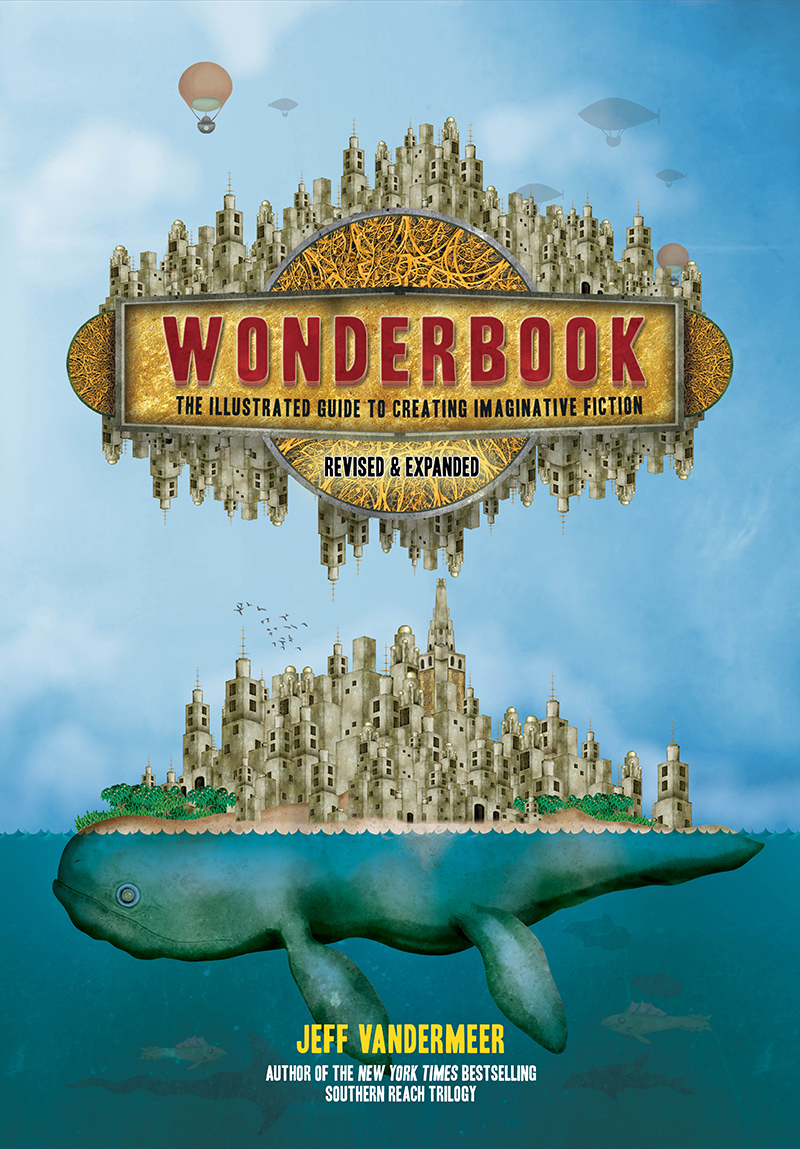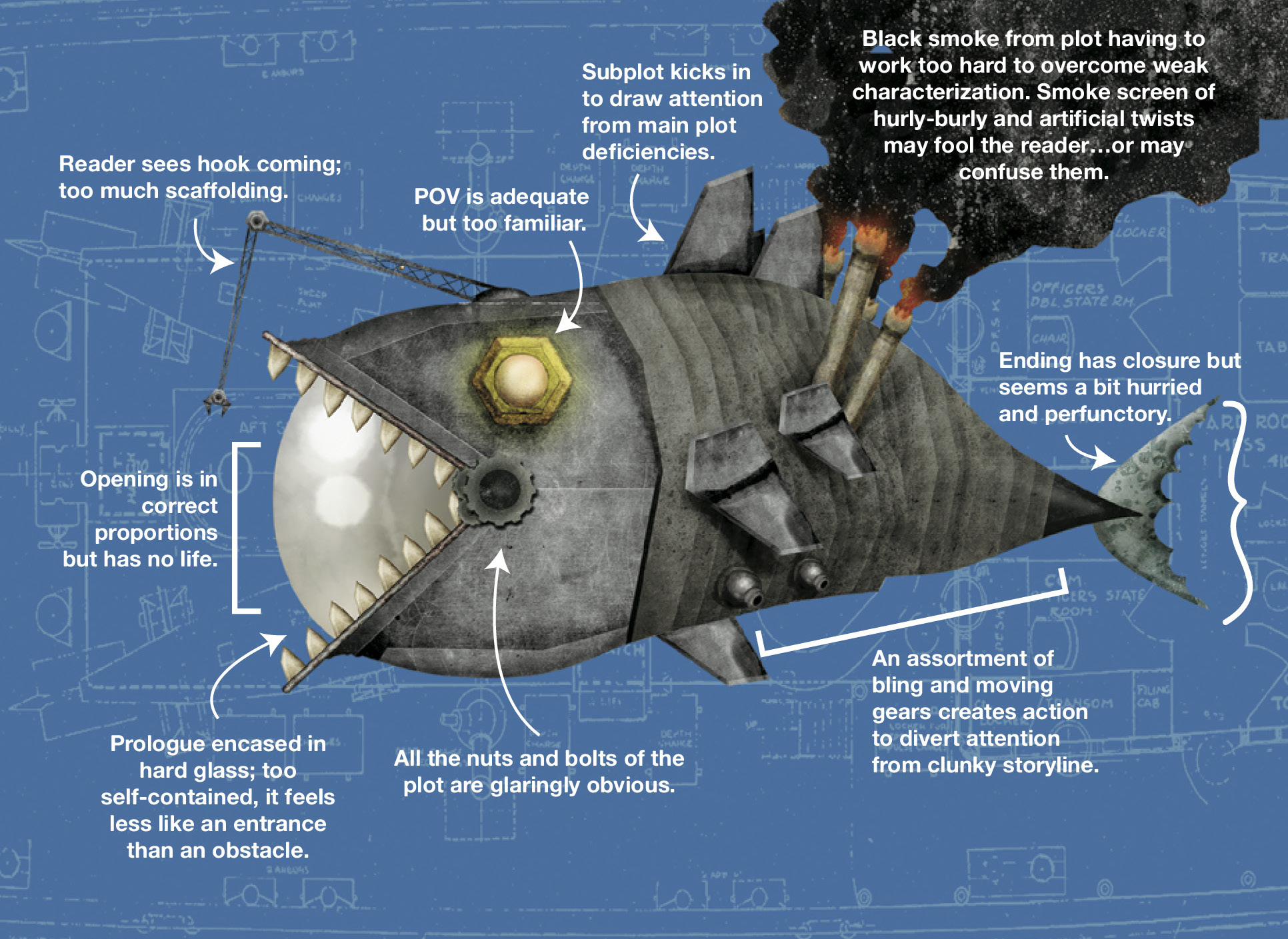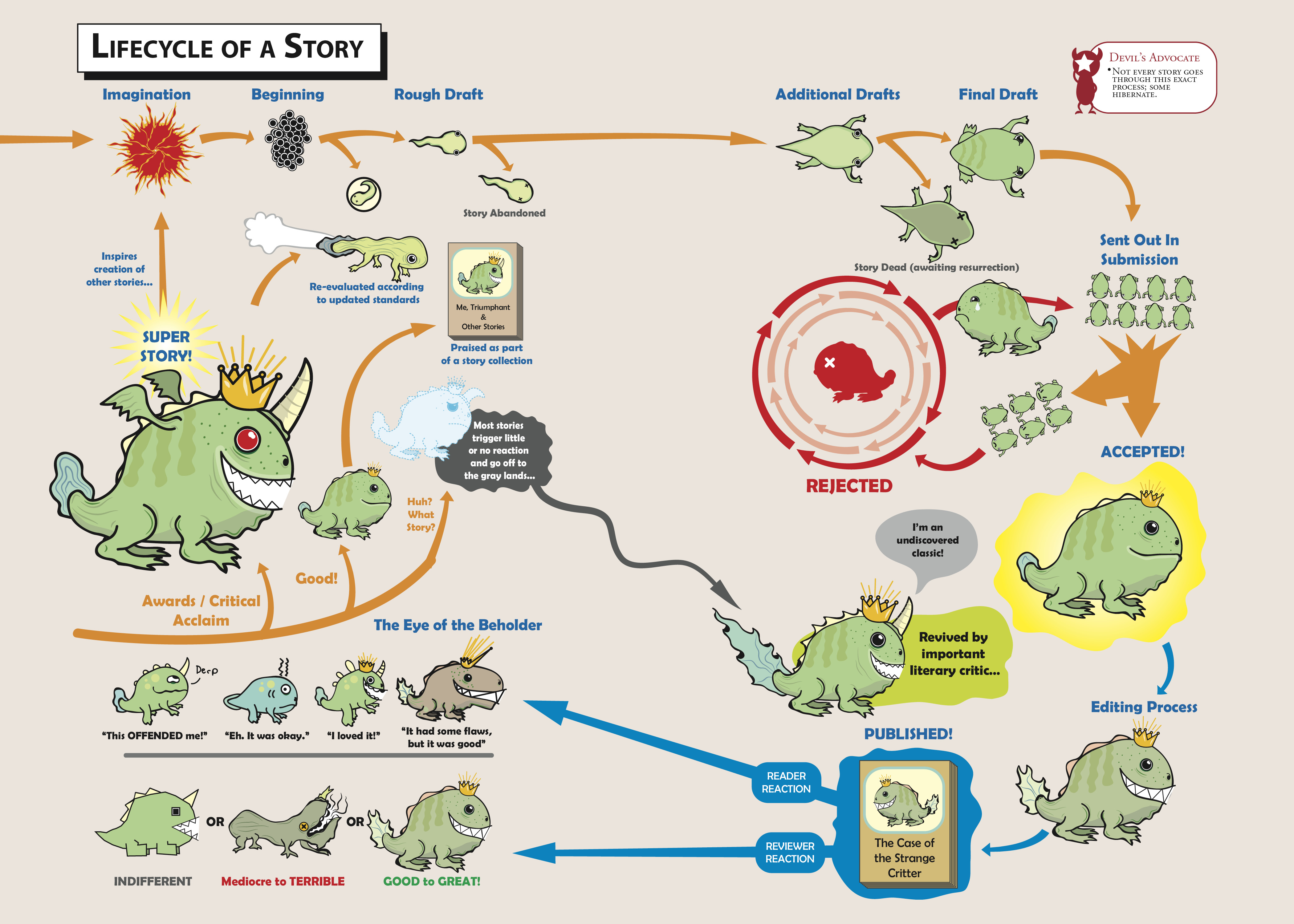'Annihilation' Author Jeff VanderMeer Shares the Secrets to Writing Great Imaginative Fiction

Aspiring writers of "imaginative fiction" — whether science fiction, fantasy or other kinds — are in for a treat: a new update to the fiction-writing guide "Wonderbook," by Jeff VanderMeer (Abrams Image, 2018).
VanderMeer is a well-known author of some of the strangest fiction today (including the "Southern Reach" trilogy that the recent movie "Annihilation" draws from), and with "Wonderbook: The Illustrated Guide to Creating Imaginative Fiction," released today (July 3, 2018) he provides an equally strange (but effective) dive into the fundamentals of fiction writing, intermingling text and illustrations to explore the complexities of fiction. The book also includes perspectives from many authors, including Kim Stanley Robinson, Ursula K. Le Guin, George R.R. Martin, Neil Gaiman and more.
"Wonderbook" first came out in 2013; this update adds 50 pages of diagrams, writing exercises and illustrations, including a discussion of how "Annihilation" was adapted into a movie. It's gorgeous to page through and substantial enough to last new (or medium) writers a good long time. [Best Space Books and Sci-Fi of 2018: A Space.com Reading List]
Space.com caught up with VanderMeer to discuss the making of the book, the key writing lessons to draw from it and what the "Annihilation" filmmaking process was like from an author's perspective.
Space.com: Why did you choose to combine visual and text elements for "Wonderbook"?
Jeff VanderMeer: The only reason it was possible to do this book is because the publisher let me work directly with the layout people and the main artist, Jeremy Zerfoss. And then I would do rough sketches of diagrams, rough sketches of illustrations, and Jeremy Zerfoss and others would do the final version … There's people that learn better visually, and there's people that learn better from words, and finding the right mix and match of that was really important. There's still about 70,[000] or 80,000 words of text.
The other thing I thought was really important is to destabilize the hierarchy of the book. There are these things called disruption dragons that run down the sides of some pages, and they include opinions from writers that are contrary to what are in the main text on the same page. I basically had a bunch of writers I really love read the text, and I said, "Don't tell me what you like about it. Tell me where you disagree." And that started a conversation in the book itself. I think that's also fairly unique. I don't really feel the kind of ownership that feels defensive about someone saying, "That doesn't jibe with what I think about writing." I think it's more important that beginning writers have access to as many different opinions about writing as possible.
Get the Space.com Newsletter
Breaking space news, the latest updates on rocket launches, skywatching events and more!

Space.com: Has the response to your book been what you expected?
VanderMeer: It does radically try to reimagine creative-writing concepts through image. I didn't realize the fact that there's a kind of high-end pop-culture comic style to some of the illustration that means that, for example, we get feedback from high school teachers that, even though some things are too complex in the book, they can take this diagram or these pages of illustrations and quickly get across something to their students about writing that often, before, took a long time to do in words or lecture.
And so the thing that I think I'm most surprised about is that it's being taught even in some middle school situations all the way up through master's programs. My favorite guides when I was growing up, when I was a beginning writer, were those that gave me all the anchor material I needed, all the basics, but also had stuff in there that was too complicated, [too] complex for where I was as a writer at the time; I would keep going back to it. The book was slightly mysterious in some ways for that reason, and so that's kind of what I wanted "Wonderbook" to do as well.
Space.com: How long was the book's design process?
VanderMeer: About three years. It pretty much took over my life. There were certain points where you feel like you're at the bottom of a deep well because you're doing something that hasn't been done before. You're exploring some new territory or another world in a weird way because you have to make it up as you're going along and still make it be cohesive and logical. And you are on an expedition, because you're doing it with all these other people who are looking to you to captain it, but you're also looking to them to give you feedback and to tell you when you're wrong about something. It's quite an interesting process.

Space.com: How did you pick the authors whose voices are in the book?
VanderMeer: This honestly goes back to Shared Worlds, the teen writing camp that I co-direct. One thing about the camp is that you have kids coming in who have never interacted with a writer before. So, in that context, you want to bring in as many different kinds of guest writers — and I don't just mean the writing, but their personalities, how they do readings, all these other things. Their perspectives are different, so they get the full range of what's possible.
So when I was thinking about the contributors to "Wonderbook," I thought kind of the same way: I wanted someone like Kim Stanley Robinson who's more on the hard sci-fi side, and loves and does well at things like extended exposition and summary [where he fleshes out the world of the story through a narrator's explanations]. And then I wanted someone like Karen Joy Fowler, who also uses science, but she does it in … not a softer way, but she writes about nonhuman species in an interesting way. She looks at the world in a way that's totally different than Robinson, even though you could say they're vaguely working in the same area. …. Nnedi Okorafor, who we've known forever — I'm so happy to have her in the book because she brings such a unique perspective from a lot of different angles. [Terraforming the Solar System: Q&A With Kim Stanley Robinson]
Space.com: In "Wonderbook," you discuss your novel "Annihilation," about a journey into the mysterious Area X, transforming into a film. Can you talk more about that process?
VanderMeer: The book immerses you in the strange place and asks you to acclimate to it … to be sucked in by the mystery of what is Area X and then learn more about the characters. And the movie, of course, is very different — it tries to acclimate you by starting out slowly, telling you more about character, situating you outside of Area X, and that's a very deliberate strategy.
It is of use for both filmmakers and fiction writers to study both points of view, because I don't think that those particular decisions are just about the medium that the two things are in. You could have made a film [that] just immersed you immediately in the mission inside Area X. You could have written a book where you started outside of Area X and you learn more about the characters. [Biggest Space Movies to Watch in 2018]
Then, there's the story about the movie that's the weirdness and the surrealness of going onto the movie set, and seeing things from the book actually, physically present. Going home and being mailed the "Annihilation" backpack, having the book signed by the whole cast — that kind of thing — that I'm still processing.
I do think the film does some really interesting things around ideas about depression, [and also] the cancer motif.; It presents a different idea of an encounter with the extraterrestrial than the books do, in some ways. So that's also valuable, because it's still a very subtle kind of thing compared to most movies. Subtle and bizarre. That last sequence is very, very strange … I really like it. [15 of the Most Bizarre Alien Species Featured in 'Star Trek']
Space.com: Were you involved in the movie's plotting?
VanderMeer: There was one initial phone call with [director] Alex Garland. [I said], "Look, it's not important that you be faithful to the book." I'm a big [Stanley] Kubrick fan, and … you can almost never recognize the book he based [a movie] on in the end. I don't think that the movie of "Annihilation" is like that, but it's definitely a radical transformation. … I didn't have much to do with it.
Going forward, I'm basically going to be a creative consultant or executive producer on everything else we have going, now that I have more of a sense of how things work. I don't like being authoritative or being creatively involved in something before I know how it works, so then I just feel like you're getting in the way.
Space.com: Can you say what else you're involved in?
VanderMeer: [The upcoming novel] "Hummingbird Salamander" was optioned by Netflix with Michael Sugar, who did "Spotlight," as the producer … I'll be an executive producer and creative consultant on [it]. And then there are two things we're on the cusp of — one is more news about one of my other novels, and one's about a short story. Unfortunately, I can't talk about it yet. But it's really exciting. I'll begin to slowly dip my toe into writing teleplays, things like that. I like, when I'm learning new stuff like that, to just do it very gradually, partner with someone, really get a sense of how it all worked. Which I think is also my process when it came to creative writing when I was a beginning writer: to slowly accrete technique and everything, and really have a sense deeply of how it worked before actually deploying it.
Space.com: Do you have a sense of what stories work best for film?
VanderMeer: I think mainly for me, no matter how subtle something is on the screen, there has to be a clear backbone or a through line that will carry the viewer along even as you maybe string all kinds of other weird stuff off of that. And that comes through character, and I think even "Annihilation," which a lot of people said was unfilmable as a novel — I totally disagree, because a lot of what we like about TV and movies is the sense of a unique character in a situation that really captures our attention. And prestige TV has really allowed us to immerse ourselves more in the interiority of characters, to some degree, in addition to plot, story, everything else. Of course, some of my novels feature things like giant, leviathan-size bears; I think those are always good on-screen.
Space.com: What are the major things you'd like people to take from "Wonderbook"?

VanderMeer: The number-one thing would be that there are so many different entry points into storytelling. And the first chapter really deals with this, that almost anything can be inspiration, that people who are prescriptive about what you should write about — it really has to be something that interests you and/or is personal to you. And if you keep that as your compass, you can't really go astray.
The second thing would be that there are things about writing that are organic, and there are things that can be mechanical. One thing that's organic is your unique imagination, and that's something that you just help flourish through imaginative play, through encouraging it, by actually doing something with the inspirations that you get. But then there's also the hard work of … When I was first starting out writing, I used way too many adjectives, to use a simple example. There's nothing wrong with mechanically going through your drafts and deleting words, having a list of things you'd want to improve and mechanically going through and doing it. There is an art and a craft, and if you don't confuse the two, the organic and the mechanical — if you know which is which and when to do either, then again, you won't lose your bearings. And I think "Wonderbook" is all about that.
This interview was edited for length. You can buy "Wonderbook" on Amazon.com.
Email Sarah Lewin at slewin@space.com or follow her @SarahExplains. Follow us @Spacedotcom, Facebook and Google+. Original article on Space.com.
Join our Space Forums to keep talking space on the latest missions, night sky and more! And if you have a news tip, correction or comment, let us know at: community@space.com.

Sarah Lewin started writing for Space.com in June of 2015 as a Staff Writer and became Associate Editor in 2019 . Her work has been featured by Scientific American, IEEE Spectrum, Quanta Magazine, Wired, The Scientist, Science Friday and WGBH's Inside NOVA. Sarah has an MA from NYU's Science, Health and Environmental Reporting Program and an AB in mathematics from Brown University. When not writing, reading or thinking about space, Sarah enjoys musical theatre and mathematical papercraft. She is currently Assistant News Editor at Scientific American. You can follow her on Twitter @SarahExplains.









